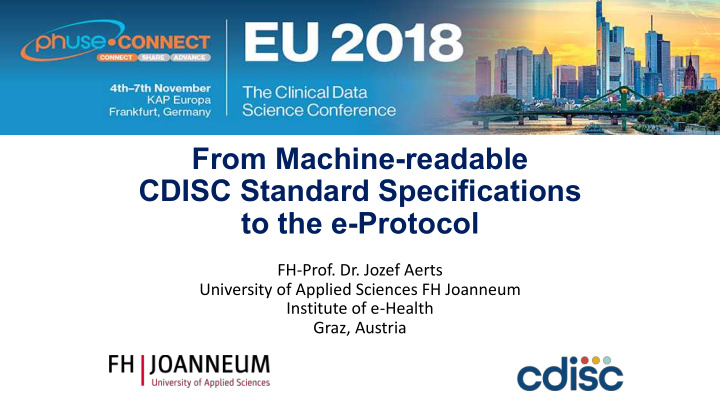



From Machine-readable CDISC Standard Specifications to the e-Protocol FH-Prof. Dr. Jozef Aerts University of Applied Sciences FH Joanneum Institute of e-Health Graz, Austria
The problems • CDISC Standards documents come as PDF / HTML • And thus are not machine-readable … • Leading to many different interpretations … • We even don't define what "must", "should", "may" mean • Other SDOs do so as the first thing in a specification • "Rules" are not machine-readable and are often confusing… • Validation tools (even those used by the FDA) are based on overinterpretation, misinterpretation and own-invented-interpretation of the standard • Often leading to many "false positives" • Protocols are not machine-readable
The problems • Only a few CDISC standards partially do have a machine-readable specification • Example: Define-XML through XML-Schema and Schematron • Allow to automate tool development and validation
The problems • Our CDISC Controlled Terminology is completely disconnected from CT used in healthcare-IT • How the hell can we retrieve information from EHRs when we use completely different CT? • We have even invented our own notation for units • Not used in healthcare-IT nor anywhere else in the world. • Not suitable for unit conversion calculations
Ok Jozef … You are complaining again, But what did YOU do?
What Jozef is doing … - a few projects • SDTM-IG in XML • SDRG in XML (Phuse project) • UCUM Units conversion and validation • Annotating clinical research protocols with coded information • "Open Rules for CDISC Standards" initiative • Really open, human-readable / machine-executable CDISC / FDA / PMDA rules for submission standards • UMLS Controlled Terminology Explorer • SHARE API 2.0 Implementations • RESTful web services for CDISC standards and CT
The SDTM-IG in XML • Although the SDTM-IGs are highly structured, they are still not machine readable • Move to HTML is not helpful … • Bachelor students project 2017 • Machine-readable IG for 46 SDTM-IG domains • XSLT stylesheet reconstructing the "human view"
The SDTM-IG in XML: Results
The SDTM-IG in XML: Results Variable definitions Assumptions
The SDTM-IG in XML: Human View (through stylesheet) Specification of the LB domain Human-readable VIEW
The SDTM-IG in XML - Future • This is all still extremely simple • "Rules" have only been added partially • Assumptions are still "human text" • Part of it has been structured (discouraged variables) • But could already be interpreted by machines • This is the way the SDTM team SHOULD publish the IG • And not as damned HTML or PDF • It is a very first step only to come to an "Alexa for SDTM"
UCUM units validation and conversion • Unified Code for Units of Measure (UCUM) is THE notation used for units in healthcare-IT • CDISC still refuses to allow usage of UCUM notation in SDTM • Has "invented" its own terminology • UCUM essentially allows conversion between ANY unit (for the same property) • A RESTful web service was developed for conversions and validations • Has been donated to and is now run at the National Library of Medicine (NLM) server CDISC SEND example:
UCUM units validation and conversion https://ucum.nlm.nih.gov/ucum-service.html
Annotated Protocols • Protocols are still written using office software • "Templates" help to structure, but "that's it" • Humans need to interpret the protocol and transform it to: • A study design • CRFs • Lab instructions • Submission data sets … • CRFs • Trial Design datasets • Clinical Trial Registry entries • And the results to SDTM and ADaM
Annotated Protocols • A format and software tool was developed to annotate "narrative" protocols with codes and terms: • SDTM Trial Design Parameters • => Automated generation of TS data sets • CDISC Controlled Terminology • LOINC, SNOMED-CT, ATC, ICD-10, UMLS, … • Making it possible to use eSource and EHRs • The "tool" uses UMLS RESTful web services for suggesting suitable codes and terms for protocol text snippets
Annotated Protocols - Movie
Annotated Protocols • Such annotated protocols are an "easy prey" for ML systems • Automated Study Design generation (in a consistent way) • Ideally in combination with MDRs • LOINC / SNOMED-CT coding => BCs • Limitations • "Schedule of Events" • => should be replaced by "workflows" https://www.a3informatics.com/biomedical-concepts/
Open Rules for CDISC Standards • Current validation rules & software: • Have been "hijacked" by regulatory authorities and a for-profit company • Some are over-interpretations of the IGs • Are often completely incorrectly implemented in software • Extremely many "false positives"
Open Rules for CDISC Standards • New initiative to publish CDISC (and FDA/PMDA?) rules in machine-executable as well as human-readable format • Envisaged to become THE reference implementation • Can be used in any modern software • By any vendor or organization • Are owned by the CDISC community • Can be written in the machine-readable IGs itself • New formal CDISC project More information coming soon …
UMLS Controlled Terminology Explorer • CDISC-CT is completely disconnected from healthcare-CT • EHRs do NOT use CDISC-CT • CDISC-CT does almost not describe any relations between terms • SYSBP with DIABP has the same relation as SYSBP with HEIGHT • But we have Unified Medical Language System UMLS! • Tries to describe relations between all coding systems in the medical world • Owned and maintained by the NLM
UMLS Controlled Terminology Explorer • We are currently developing a software tool to explore relationships between CDISC-CT and CT from healthcare-IT • Based on UMLS RESTful Web Services • Generates graphs of relationships • Leading to a "knowledge network" • Still a lot "todo", but it works …
UMLS Controlled Terminology Explorer
A few more CDISC-related projects Jozef is working on …
Recommend
More recommend